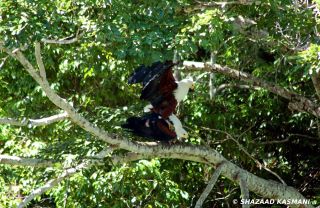“The Eagle Has Landed”
Photo Credit: Shazaad Kasmani
- Order: Falconiformes
- Family: : Accipitridae
- Genus: Haliaeetus
- Species: H. vocifer
The African Fish Eagle or African Sea Eagle (Haliaeetus vocifer) is the national bird of Zimbabwe and Zambia. They are found all throughout sub-Saharan Africa, wherever large bodies of open water occur (due to their fishy diet). Its distinctive cry is, for many, evocative of the spirit or essence of Africa. Though they somewhat resemble the American Bald Eagle, the two are found on completely different continents. Their closest relative is the critically endangered Madagascar Fish Eagle (Haliaeetus vocifer). Like all sea eagles they consists of a white headed (the African Fish Eagle) and a tan headed variety.
The African Fish Eagle is a very large bird of prey, and the females (7-8 pounds, or 3.2-3.6 kilograms) are actually get bigger than the males (4.4-5.5 pounds, or 2-2.5 kilograms). The females have wingspans of around 8 feet (2.4 meters), while the males have ones of about about 6 feet (2 meters). This sexual dimorphism is actually quite common among birds of prey. Adults are usually 25-30 inches (63-75 centimeters) long, with mostly brown bodies, and large powerful black wings. The head, breast, and tail are all snow white. The eyes are dark brown in color. The the face is featherless and yellow, with a black tip on it’s hook shaped beak. The feet have rough soles that are equipped with powerful talons in order to grasp slippery aquatic prey.
While these birds mainly dine on fish, they may take a wider variety of prey if the opportunity presents itself, such as waterbirds. Their keen eyesight, sharp talons, and hooked beak are all designed perfectly for this carnivorous lifestyle. Upon spotting potential prey from their perch, they will swoop down upon and snatch the prey from the water with its large clawed talons. Like other sea eagles, the African Fish Eagle has structures on its toes called spiricules that facilitate grabbing fish and other slippery prey. Should the Eagle catch a fish that is too heavy to bring back to it’s perch, it will instead drag the fish across the surface of the water to shore. If it’s too big to even begin to raise out of the water, the Eagle may drop into the water and paddle to the nearest shore with it’s wings! A true predator in every sense of the word, it has been known to feed on ducks, small turtles and terrapins, baby crocodiles, Greater Flamingos and Lesser Flamingos, lizards such as Nile Monitors, frogs and even carrion. Occasionally, it may even carry off mammalian prey, such as hyraxes and monkeys. It has also been observed feeding on domestic chickens.
People say that African Fish Eagles mate for life. Pairs will often maintain multiple nests, which they frequently reuse. Because nests are reused and built upon over the years, the nests can grow to be quite large, some reaching 6 feet (2 meters) across and 4 feet (1.2 m) deep; they are built of sticks and other pieces of wood. Females typically lay 1-3 white with reddish speckled eggs. Incubation is done by the female, but the male will incubate while the female hunts. After 42-45 days, the chicks will hatch, and the first one to hatch usually kills off all the younger chicks; known as siblicide, this tactic is common among birds of prey. The fledgling period usually lasts 70-75 days, and after about 8 weeks the chicks are completely able to feet themselves.
To share your wildlife photos with the Bush Warriors community, go to our Photo of the Day Contest Facebook page and upload your shots today! Please click here to view ALL of our Photo of the Day winners and for more information on the Bush Warriors Photo of the Day Contest. Enjoy the beauty of nature, just as it was intended to be!
The Bush Warriors Photo of The Day Contest is brought to you in partnership with Creative Visions Foundation. Inspired by the life of Dan Eldon, a young Reuters photojournalist killed in Somalia in 1993, Creative Visions Foundation supports “Creative Activists” who use media and the arts to create positive change in the world.
Vote for your favorite photo each week. The Bush Warriors Photo of The Week winner will go on to compete for the Bush Warriors Photo of the Month, and a chance to win a signed copy of Dan Eldon: Safari As a Way of Life of life.





beautiful beautiful bird!!!!!!!! would n;t it be cool if we had some audio to hear how this eagle sounds……Thanks, BW.you did it again….xoxo